University Staff Management Assessment: Conflict Resolution Strategies
VerifiedAdded on 2021/04/24
|13
|2453
|158
Report
AI Summary
This report, focusing on staff management and conflict resolution within the hospitality industry, addresses various aspects of workplace conflict. It begins by identifying signs of potential conflict in diverse scenarios such as product delays, difficult customers, and product faults. The report highlights potential threats to customer safety, including unprofessional staff conduct and data security concerns, and suggests measures to mitigate these risks. It outlines the roles of different groups, including management and conflict managers, in resolving conflicts and provides examples of impact minimization strategies. The report also examines the effects of conflict on business reputation and legal liabilities, suggesting effective communication methods to address conflict situations. Furthermore, the report analyzes different types of conflict, common causes, and suggests resolution strategies. It delves into conflict theory, conflict resolution techniques, and organizational policies for conflict management, and identifies the causes of workplace conflict. The report concludes with a comprehensive analysis of the subject, providing valuable insights into staff management and conflict resolution in a business setting.
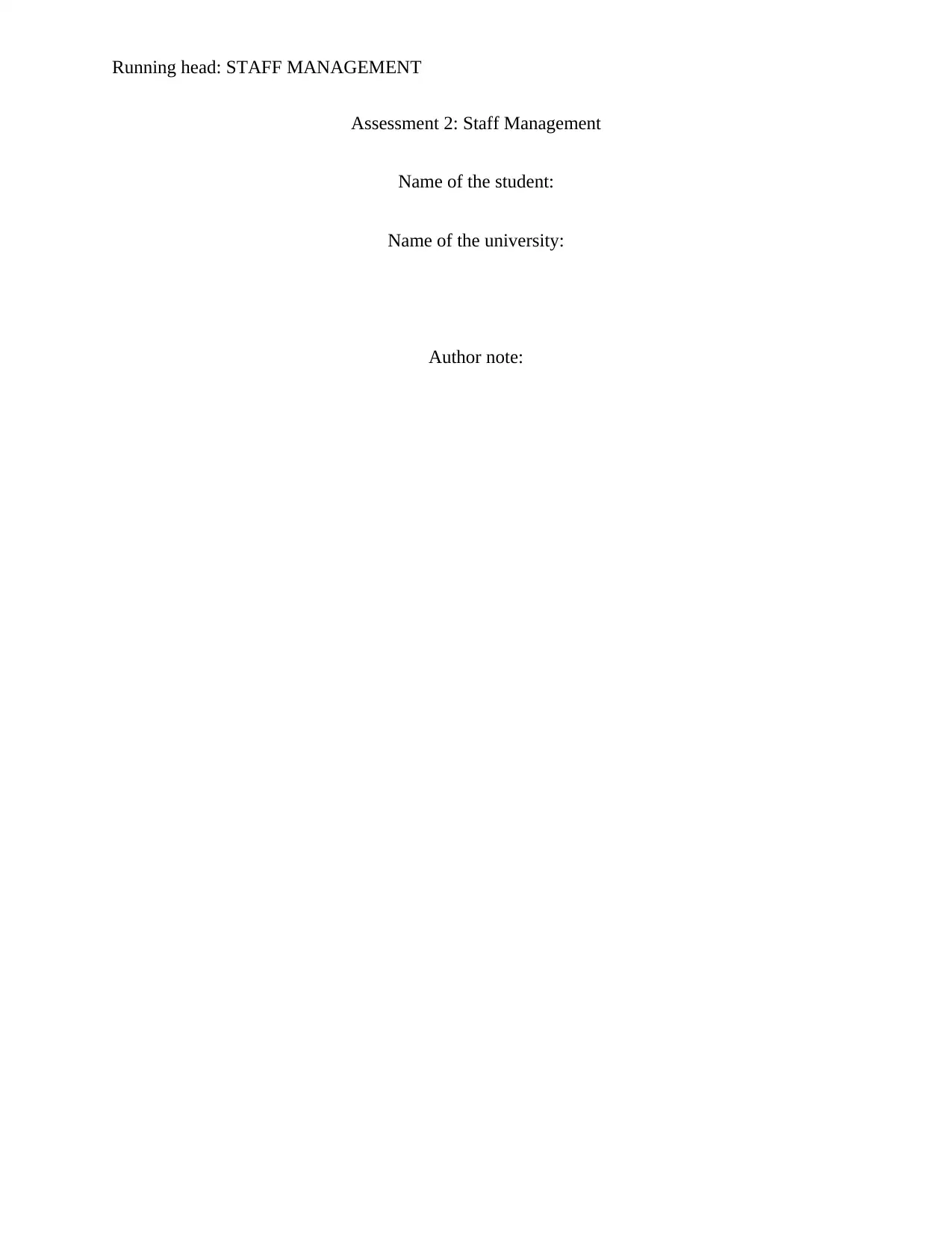
Running head: STAFF MANAGEMENT
Assessment 2: Staff Management
Name of the student:
Name of the university:
Author note:
Assessment 2: Staff Management
Name of the student:
Name of the university:
Author note:
Paraphrase This Document
Need a fresh take? Get an instant paraphrase of this document with our AI Paraphraser
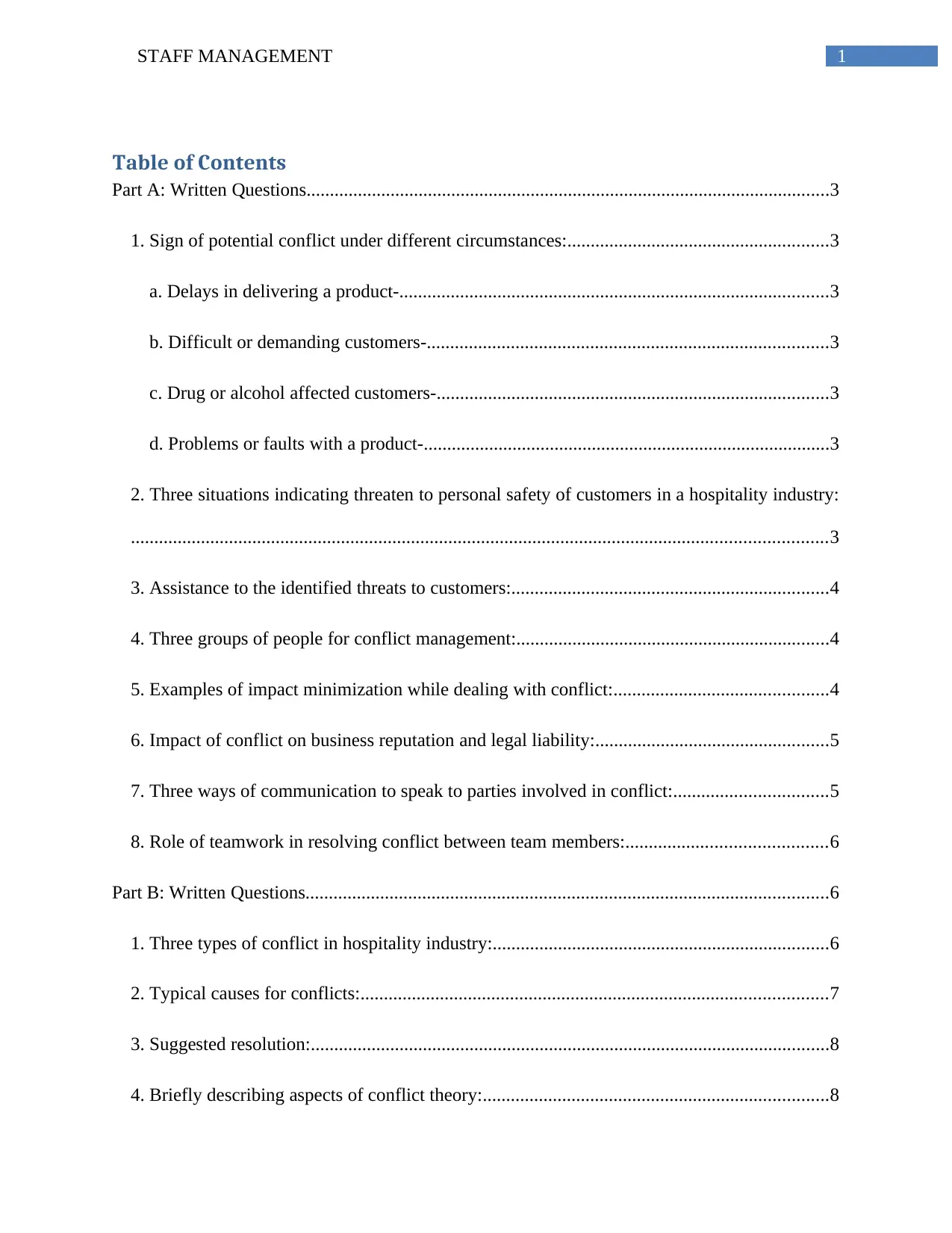
1STAFF MANAGEMENT
Table of Contents
Part A: Written Questions................................................................................................................3
1. Sign of potential conflict under different circumstances:........................................................3
a. Delays in delivering a product-............................................................................................3
b. Difficult or demanding customers-......................................................................................3
c. Drug or alcohol affected customers-....................................................................................3
d. Problems or faults with a product-.......................................................................................3
2. Three situations indicating threaten to personal safety of customers in a hospitality industry:
.....................................................................................................................................................3
3. Assistance to the identified threats to customers:....................................................................4
4. Three groups of people for conflict management:...................................................................4
5. Examples of impact minimization while dealing with conflict:..............................................4
6. Impact of conflict on business reputation and legal liability:..................................................5
7. Three ways of communication to speak to parties involved in conflict:.................................5
8. Role of teamwork in resolving conflict between team members:...........................................6
Part B: Written Questions................................................................................................................6
1. Three types of conflict in hospitality industry:........................................................................6
2. Typical causes for conflicts:....................................................................................................7
3. Suggested resolution:...............................................................................................................8
4. Briefly describing aspects of conflict theory:..........................................................................8
Table of Contents
Part A: Written Questions................................................................................................................3
1. Sign of potential conflict under different circumstances:........................................................3
a. Delays in delivering a product-............................................................................................3
b. Difficult or demanding customers-......................................................................................3
c. Drug or alcohol affected customers-....................................................................................3
d. Problems or faults with a product-.......................................................................................3
2. Three situations indicating threaten to personal safety of customers in a hospitality industry:
.....................................................................................................................................................3
3. Assistance to the identified threats to customers:....................................................................4
4. Three groups of people for conflict management:...................................................................4
5. Examples of impact minimization while dealing with conflict:..............................................4
6. Impact of conflict on business reputation and legal liability:..................................................5
7. Three ways of communication to speak to parties involved in conflict:.................................5
8. Role of teamwork in resolving conflict between team members:...........................................6
Part B: Written Questions................................................................................................................6
1. Three types of conflict in hospitality industry:........................................................................6
2. Typical causes for conflicts:....................................................................................................7
3. Suggested resolution:...............................................................................................................8
4. Briefly describing aspects of conflict theory:..........................................................................8
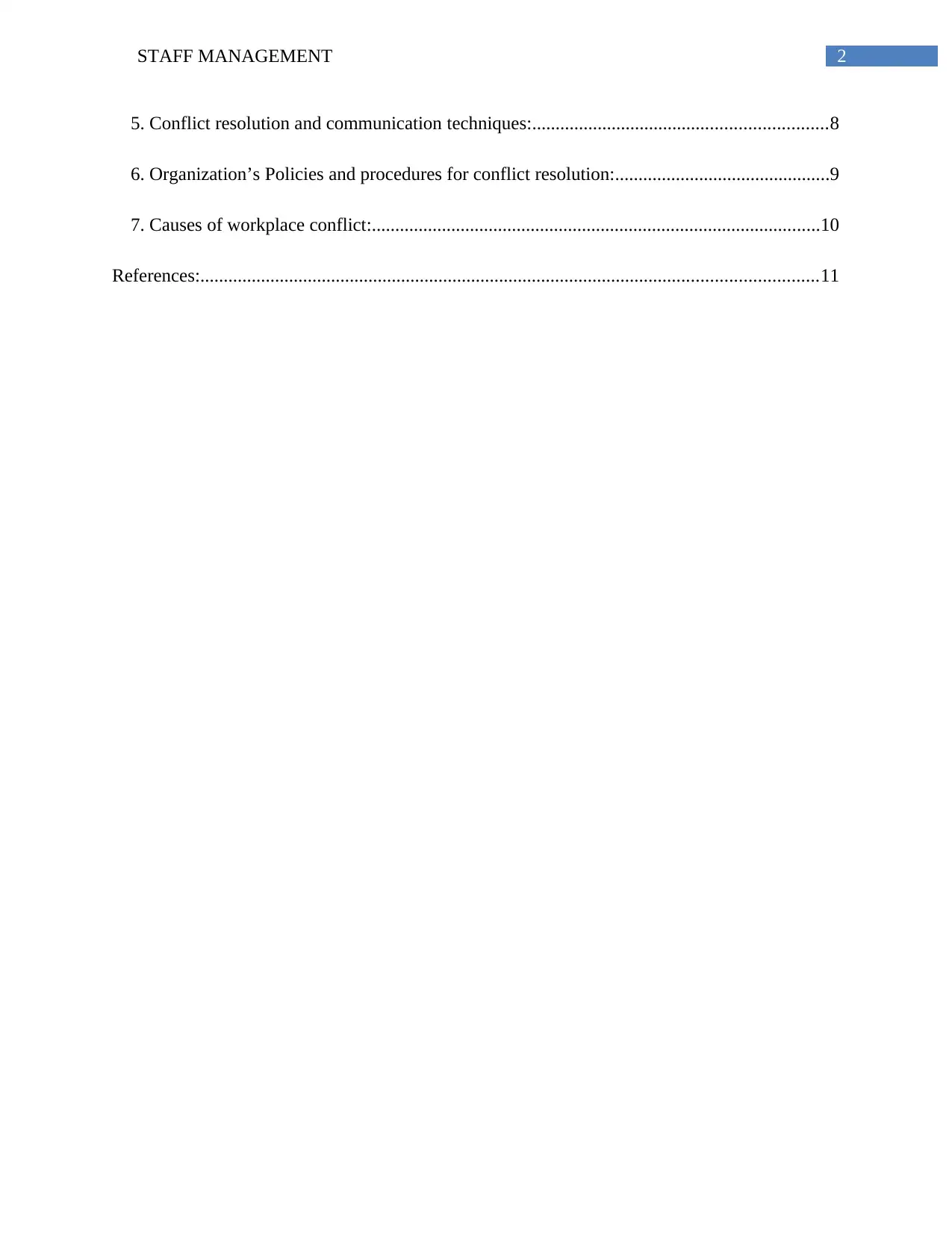
2STAFF MANAGEMENT
5. Conflict resolution and communication techniques:...............................................................8
6. Organization’s Policies and procedures for conflict resolution:..............................................9
7. Causes of workplace conflict:................................................................................................10
References:....................................................................................................................................11
5. Conflict resolution and communication techniques:...............................................................8
6. Organization’s Policies and procedures for conflict resolution:..............................................9
7. Causes of workplace conflict:................................................................................................10
References:....................................................................................................................................11
⊘ This is a preview!⊘
Do you want full access?
Subscribe today to unlock all pages.

Trusted by 1+ million students worldwide
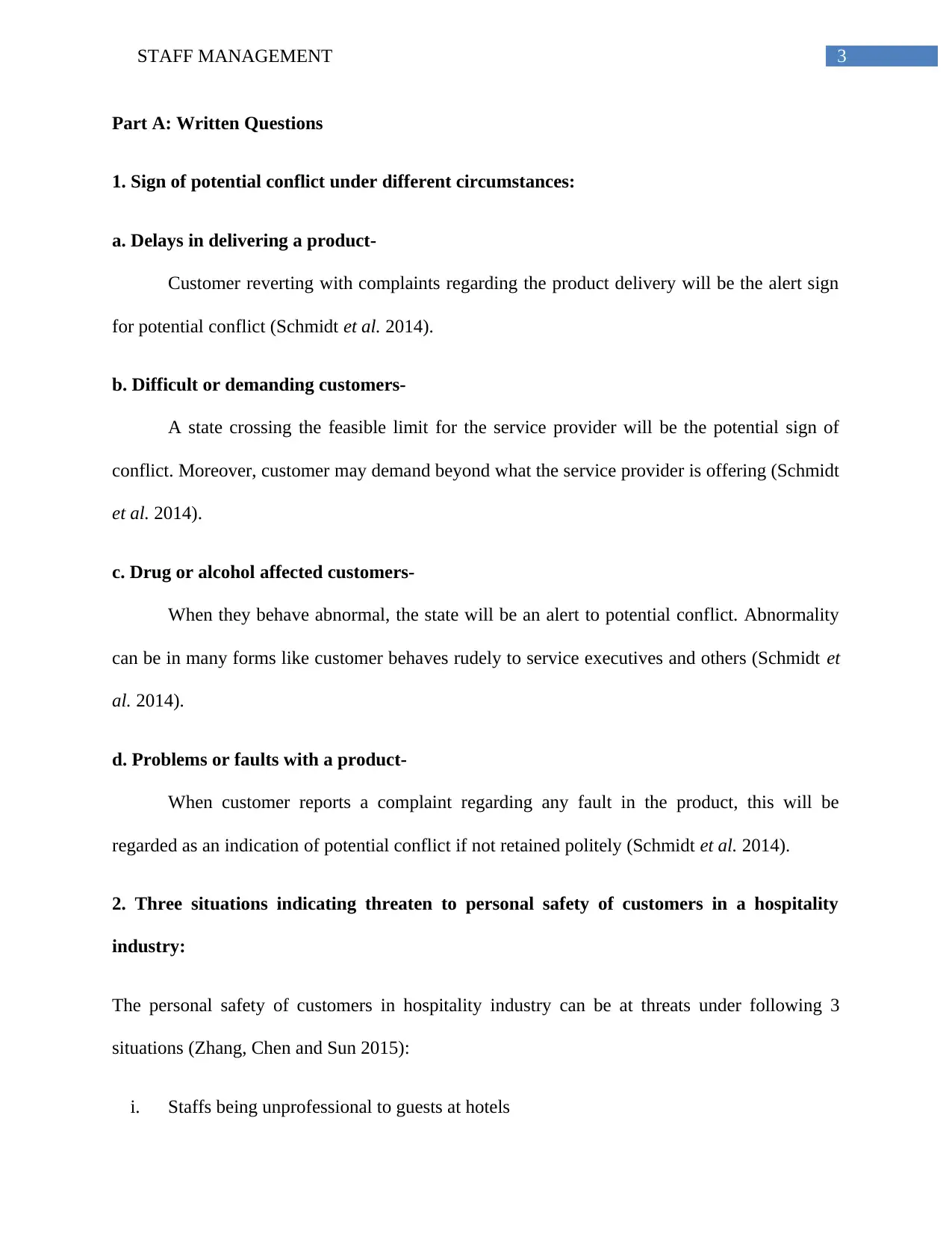
3STAFF MANAGEMENT
Part A: Written Questions
1. Sign of potential conflict under different circumstances:
a. Delays in delivering a product-
Customer reverting with complaints regarding the product delivery will be the alert sign
for potential conflict (Schmidt et al. 2014).
b. Difficult or demanding customers-
A state crossing the feasible limit for the service provider will be the potential sign of
conflict. Moreover, customer may demand beyond what the service provider is offering (Schmidt
et al. 2014).
c. Drug or alcohol affected customers-
When they behave abnormal, the state will be an alert to potential conflict. Abnormality
can be in many forms like customer behaves rudely to service executives and others (Schmidt et
al. 2014).
d. Problems or faults with a product-
When customer reports a complaint regarding any fault in the product, this will be
regarded as an indication of potential conflict if not retained politely (Schmidt et al. 2014).
2. Three situations indicating threaten to personal safety of customers in a hospitality
industry:
The personal safety of customers in hospitality industry can be at threats under following 3
situations (Zhang, Chen and Sun 2015):
i. Staffs being unprofessional to guests at hotels
Part A: Written Questions
1. Sign of potential conflict under different circumstances:
a. Delays in delivering a product-
Customer reverting with complaints regarding the product delivery will be the alert sign
for potential conflict (Schmidt et al. 2014).
b. Difficult or demanding customers-
A state crossing the feasible limit for the service provider will be the potential sign of
conflict. Moreover, customer may demand beyond what the service provider is offering (Schmidt
et al. 2014).
c. Drug or alcohol affected customers-
When they behave abnormal, the state will be an alert to potential conflict. Abnormality
can be in many forms like customer behaves rudely to service executives and others (Schmidt et
al. 2014).
d. Problems or faults with a product-
When customer reports a complaint regarding any fault in the product, this will be
regarded as an indication of potential conflict if not retained politely (Schmidt et al. 2014).
2. Three situations indicating threaten to personal safety of customers in a hospitality
industry:
The personal safety of customers in hospitality industry can be at threats under following 3
situations (Zhang, Chen and Sun 2015):
i. Staffs being unprofessional to guests at hotels
Paraphrase This Document
Need a fresh take? Get an instant paraphrase of this document with our AI Paraphraser
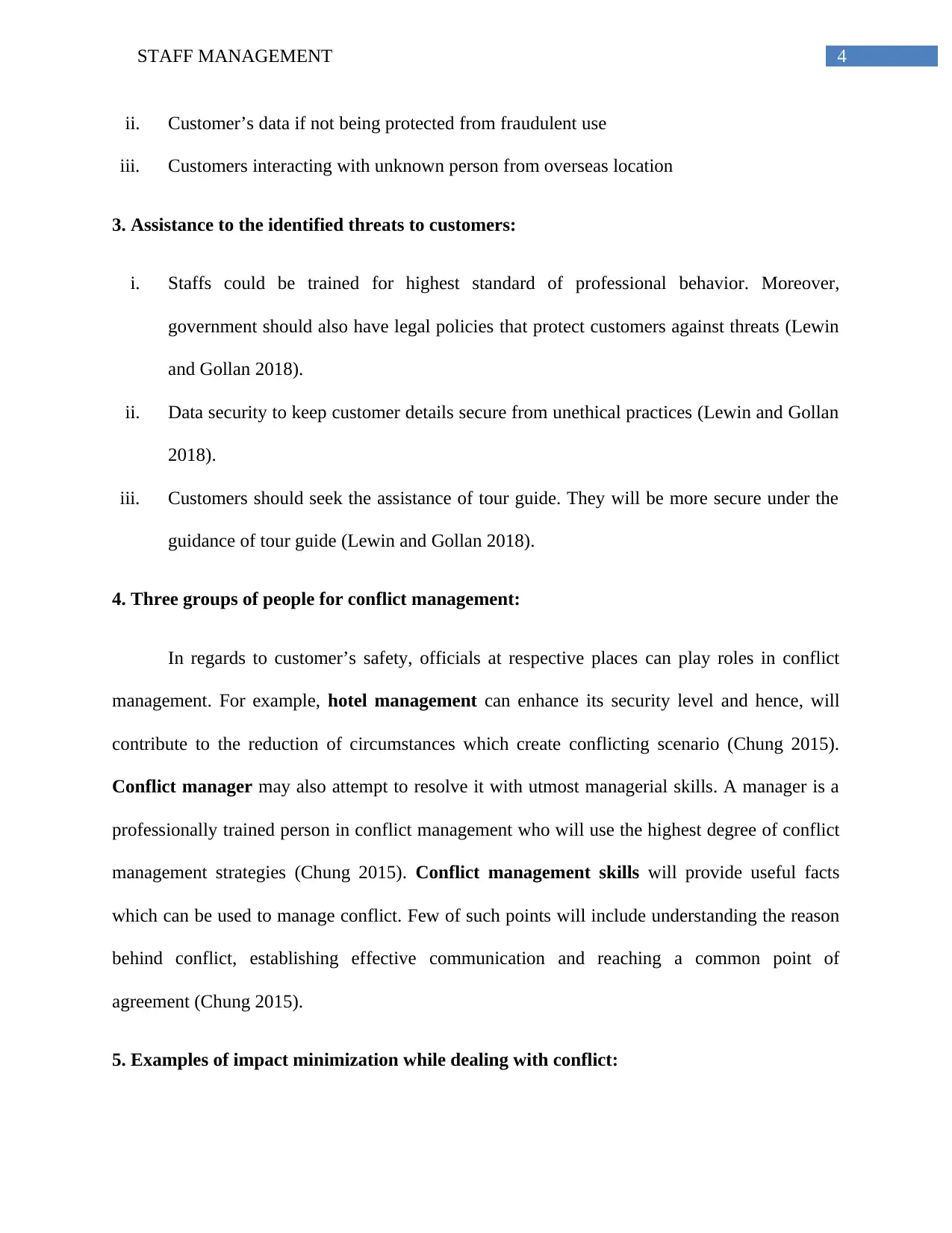
4STAFF MANAGEMENT
ii. Customer’s data if not being protected from fraudulent use
iii. Customers interacting with unknown person from overseas location
3. Assistance to the identified threats to customers:
i. Staffs could be trained for highest standard of professional behavior. Moreover,
government should also have legal policies that protect customers against threats (Lewin
and Gollan 2018).
ii. Data security to keep customer details secure from unethical practices (Lewin and Gollan
2018).
iii. Customers should seek the assistance of tour guide. They will be more secure under the
guidance of tour guide (Lewin and Gollan 2018).
4. Three groups of people for conflict management:
In regards to customer’s safety, officials at respective places can play roles in conflict
management. For example, hotel management can enhance its security level and hence, will
contribute to the reduction of circumstances which create conflicting scenario (Chung 2015).
Conflict manager may also attempt to resolve it with utmost managerial skills. A manager is a
professionally trained person in conflict management who will use the highest degree of conflict
management strategies (Chung 2015). Conflict management skills will provide useful facts
which can be used to manage conflict. Few of such points will include understanding the reason
behind conflict, establishing effective communication and reaching a common point of
agreement (Chung 2015).
5. Examples of impact minimization while dealing with conflict:
ii. Customer’s data if not being protected from fraudulent use
iii. Customers interacting with unknown person from overseas location
3. Assistance to the identified threats to customers:
i. Staffs could be trained for highest standard of professional behavior. Moreover,
government should also have legal policies that protect customers against threats (Lewin
and Gollan 2018).
ii. Data security to keep customer details secure from unethical practices (Lewin and Gollan
2018).
iii. Customers should seek the assistance of tour guide. They will be more secure under the
guidance of tour guide (Lewin and Gollan 2018).
4. Three groups of people for conflict management:
In regards to customer’s safety, officials at respective places can play roles in conflict
management. For example, hotel management can enhance its security level and hence, will
contribute to the reduction of circumstances which create conflicting scenario (Chung 2015).
Conflict manager may also attempt to resolve it with utmost managerial skills. A manager is a
professionally trained person in conflict management who will use the highest degree of conflict
management strategies (Chung 2015). Conflict management skills will provide useful facts
which can be used to manage conflict. Few of such points will include understanding the reason
behind conflict, establishing effective communication and reaching a common point of
agreement (Chung 2015).
5. Examples of impact minimization while dealing with conflict:
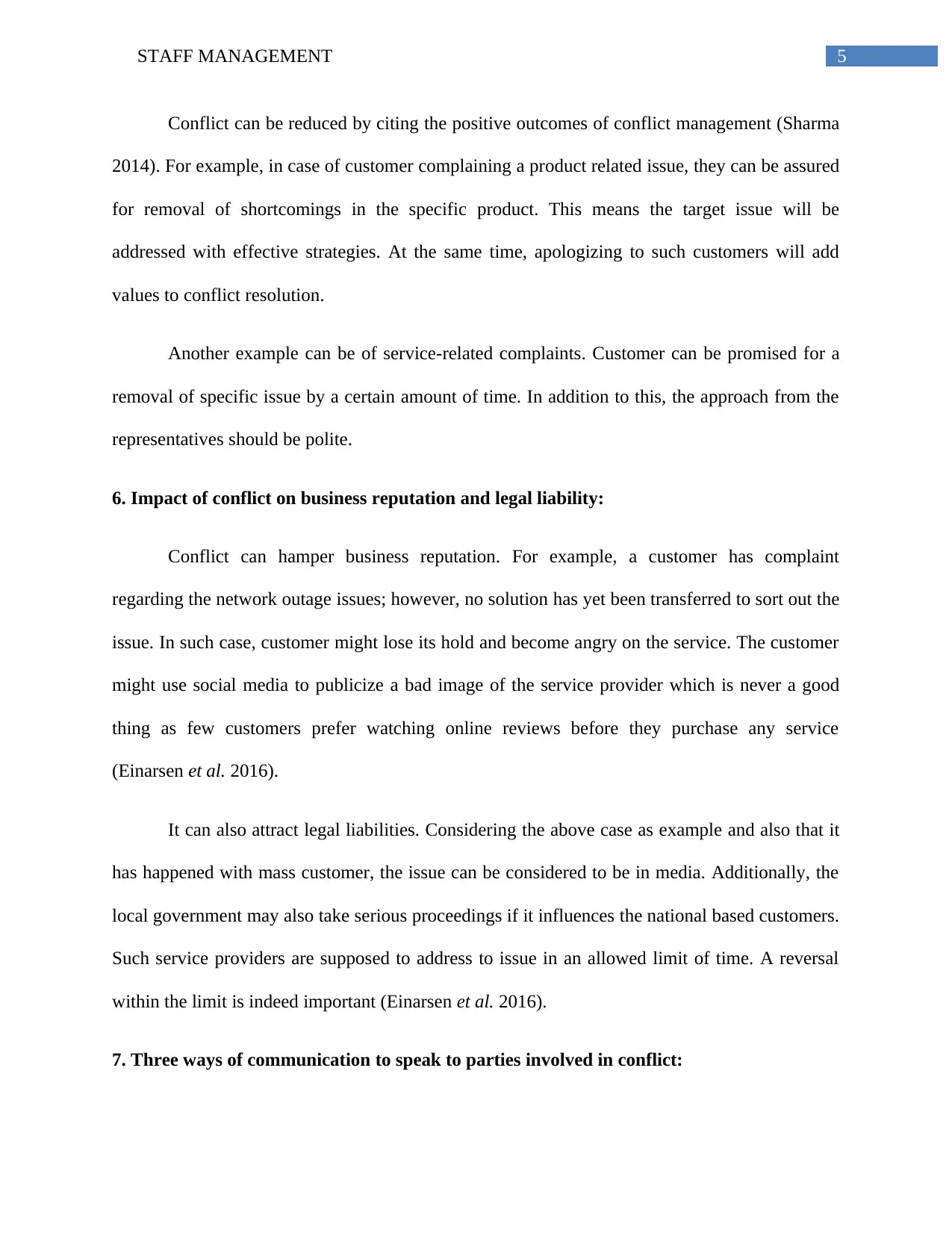
5STAFF MANAGEMENT
Conflict can be reduced by citing the positive outcomes of conflict management (Sharma
2014). For example, in case of customer complaining a product related issue, they can be assured
for removal of shortcomings in the specific product. This means the target issue will be
addressed with effective strategies. At the same time, apologizing to such customers will add
values to conflict resolution.
Another example can be of service-related complaints. Customer can be promised for a
removal of specific issue by a certain amount of time. In addition to this, the approach from the
representatives should be polite.
6. Impact of conflict on business reputation and legal liability:
Conflict can hamper business reputation. For example, a customer has complaint
regarding the network outage issues; however, no solution has yet been transferred to sort out the
issue. In such case, customer might lose its hold and become angry on the service. The customer
might use social media to publicize a bad image of the service provider which is never a good
thing as few customers prefer watching online reviews before they purchase any service
(Einarsen et al. 2016).
It can also attract legal liabilities. Considering the above case as example and also that it
has happened with mass customer, the issue can be considered to be in media. Additionally, the
local government may also take serious proceedings if it influences the national based customers.
Such service providers are supposed to address to issue in an allowed limit of time. A reversal
within the limit is indeed important (Einarsen et al. 2016).
7. Three ways of communication to speak to parties involved in conflict:
Conflict can be reduced by citing the positive outcomes of conflict management (Sharma
2014). For example, in case of customer complaining a product related issue, they can be assured
for removal of shortcomings in the specific product. This means the target issue will be
addressed with effective strategies. At the same time, apologizing to such customers will add
values to conflict resolution.
Another example can be of service-related complaints. Customer can be promised for a
removal of specific issue by a certain amount of time. In addition to this, the approach from the
representatives should be polite.
6. Impact of conflict on business reputation and legal liability:
Conflict can hamper business reputation. For example, a customer has complaint
regarding the network outage issues; however, no solution has yet been transferred to sort out the
issue. In such case, customer might lose its hold and become angry on the service. The customer
might use social media to publicize a bad image of the service provider which is never a good
thing as few customers prefer watching online reviews before they purchase any service
(Einarsen et al. 2016).
It can also attract legal liabilities. Considering the above case as example and also that it
has happened with mass customer, the issue can be considered to be in media. Additionally, the
local government may also take serious proceedings if it influences the national based customers.
Such service providers are supposed to address to issue in an allowed limit of time. A reversal
within the limit is indeed important (Einarsen et al. 2016).
7. Three ways of communication to speak to parties involved in conflict:
⊘ This is a preview!⊘
Do you want full access?
Subscribe today to unlock all pages.

Trusted by 1+ million students worldwide
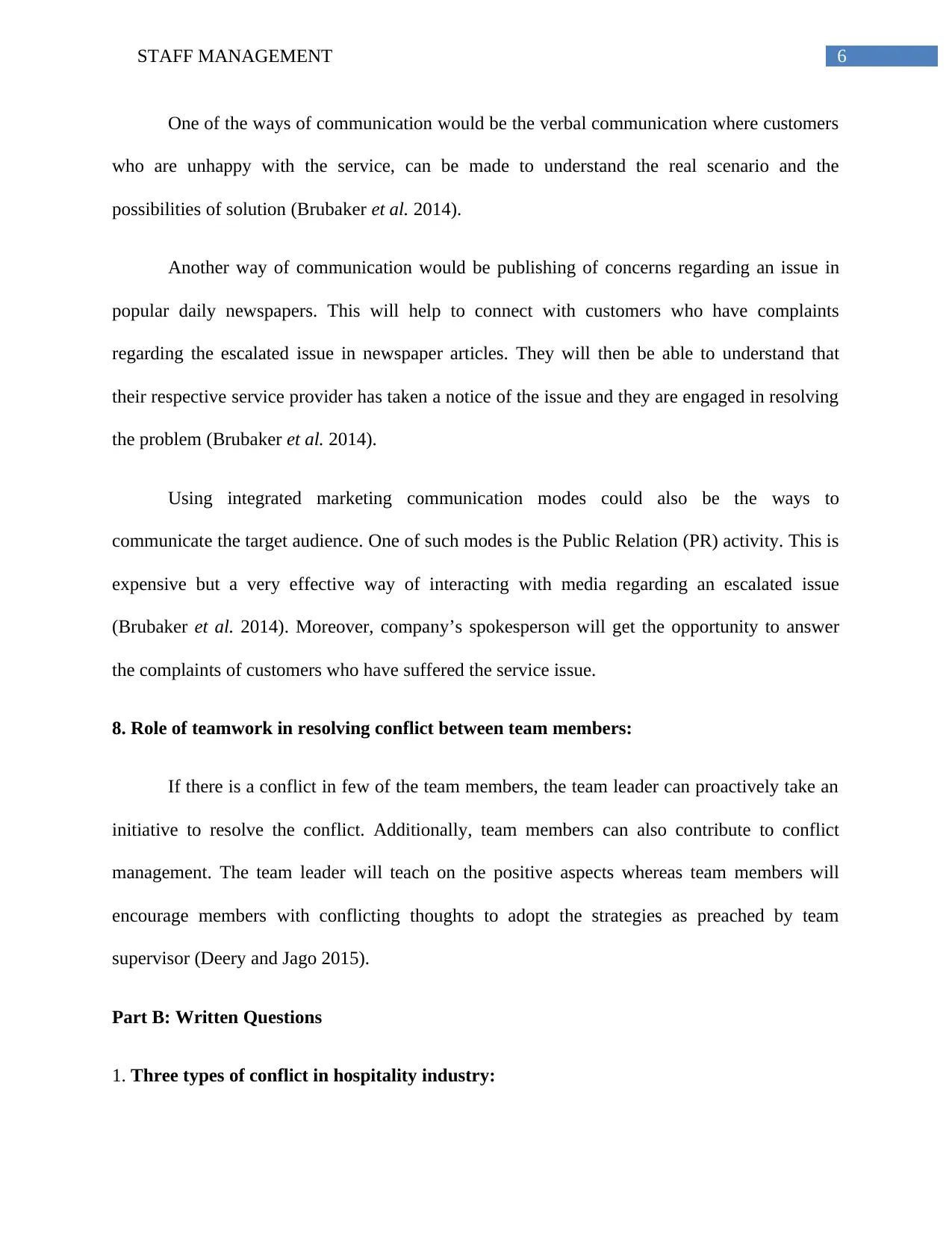
6STAFF MANAGEMENT
One of the ways of communication would be the verbal communication where customers
who are unhappy with the service, can be made to understand the real scenario and the
possibilities of solution (Brubaker et al. 2014).
Another way of communication would be publishing of concerns regarding an issue in
popular daily newspapers. This will help to connect with customers who have complaints
regarding the escalated issue in newspaper articles. They will then be able to understand that
their respective service provider has taken a notice of the issue and they are engaged in resolving
the problem (Brubaker et al. 2014).
Using integrated marketing communication modes could also be the ways to
communicate the target audience. One of such modes is the Public Relation (PR) activity. This is
expensive but a very effective way of interacting with media regarding an escalated issue
(Brubaker et al. 2014). Moreover, company’s spokesperson will get the opportunity to answer
the complaints of customers who have suffered the service issue.
8. Role of teamwork in resolving conflict between team members:
If there is a conflict in few of the team members, the team leader can proactively take an
initiative to resolve the conflict. Additionally, team members can also contribute to conflict
management. The team leader will teach on the positive aspects whereas team members will
encourage members with conflicting thoughts to adopt the strategies as preached by team
supervisor (Deery and Jago 2015).
Part B: Written Questions
1. Three types of conflict in hospitality industry:
One of the ways of communication would be the verbal communication where customers
who are unhappy with the service, can be made to understand the real scenario and the
possibilities of solution (Brubaker et al. 2014).
Another way of communication would be publishing of concerns regarding an issue in
popular daily newspapers. This will help to connect with customers who have complaints
regarding the escalated issue in newspaper articles. They will then be able to understand that
their respective service provider has taken a notice of the issue and they are engaged in resolving
the problem (Brubaker et al. 2014).
Using integrated marketing communication modes could also be the ways to
communicate the target audience. One of such modes is the Public Relation (PR) activity. This is
expensive but a very effective way of interacting with media regarding an escalated issue
(Brubaker et al. 2014). Moreover, company’s spokesperson will get the opportunity to answer
the complaints of customers who have suffered the service issue.
8. Role of teamwork in resolving conflict between team members:
If there is a conflict in few of the team members, the team leader can proactively take an
initiative to resolve the conflict. Additionally, team members can also contribute to conflict
management. The team leader will teach on the positive aspects whereas team members will
encourage members with conflicting thoughts to adopt the strategies as preached by team
supervisor (Deery and Jago 2015).
Part B: Written Questions
1. Three types of conflict in hospitality industry:
Paraphrase This Document
Need a fresh take? Get an instant paraphrase of this document with our AI Paraphraser
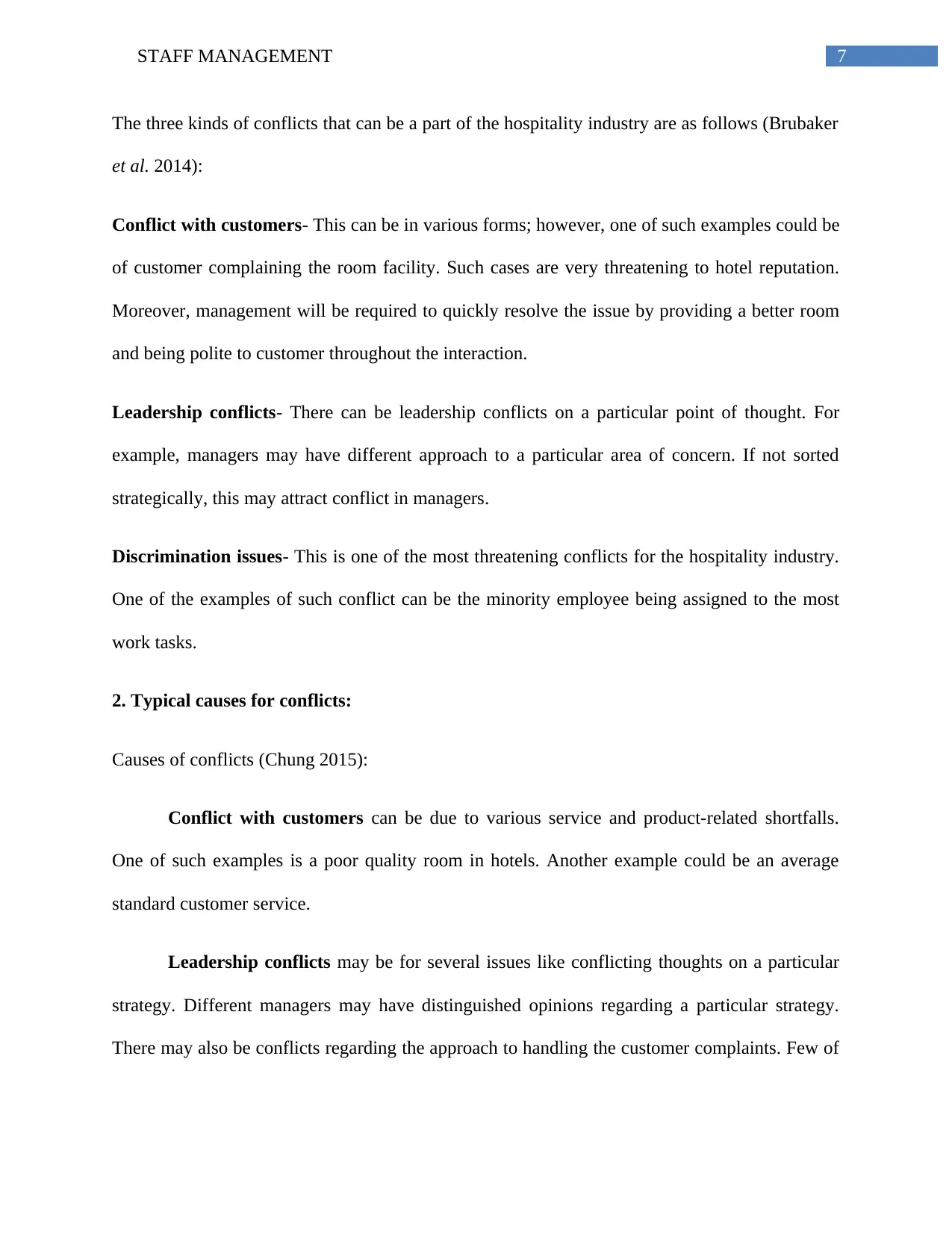
7STAFF MANAGEMENT
The three kinds of conflicts that can be a part of the hospitality industry are as follows (Brubaker
et al. 2014):
Conflict with customers- This can be in various forms; however, one of such examples could be
of customer complaining the room facility. Such cases are very threatening to hotel reputation.
Moreover, management will be required to quickly resolve the issue by providing a better room
and being polite to customer throughout the interaction.
Leadership conflicts- There can be leadership conflicts on a particular point of thought. For
example, managers may have different approach to a particular area of concern. If not sorted
strategically, this may attract conflict in managers.
Discrimination issues- This is one of the most threatening conflicts for the hospitality industry.
One of the examples of such conflict can be the minority employee being assigned to the most
work tasks.
2. Typical causes for conflicts:
Causes of conflicts (Chung 2015):
Conflict with customers can be due to various service and product-related shortfalls.
One of such examples is a poor quality room in hotels. Another example could be an average
standard customer service.
Leadership conflicts may be for several issues like conflicting thoughts on a particular
strategy. Different managers may have distinguished opinions regarding a particular strategy.
There may also be conflicts regarding the approach to handling the customer complaints. Few of
The three kinds of conflicts that can be a part of the hospitality industry are as follows (Brubaker
et al. 2014):
Conflict with customers- This can be in various forms; however, one of such examples could be
of customer complaining the room facility. Such cases are very threatening to hotel reputation.
Moreover, management will be required to quickly resolve the issue by providing a better room
and being polite to customer throughout the interaction.
Leadership conflicts- There can be leadership conflicts on a particular point of thought. For
example, managers may have different approach to a particular area of concern. If not sorted
strategically, this may attract conflict in managers.
Discrimination issues- This is one of the most threatening conflicts for the hospitality industry.
One of the examples of such conflict can be the minority employee being assigned to the most
work tasks.
2. Typical causes for conflicts:
Causes of conflicts (Chung 2015):
Conflict with customers can be due to various service and product-related shortfalls.
One of such examples is a poor quality room in hotels. Another example could be an average
standard customer service.
Leadership conflicts may be for several issues like conflicting thoughts on a particular
strategy. Different managers may have distinguished opinions regarding a particular strategy.
There may also be conflicts regarding the approach to handling the customer complaints. Few of
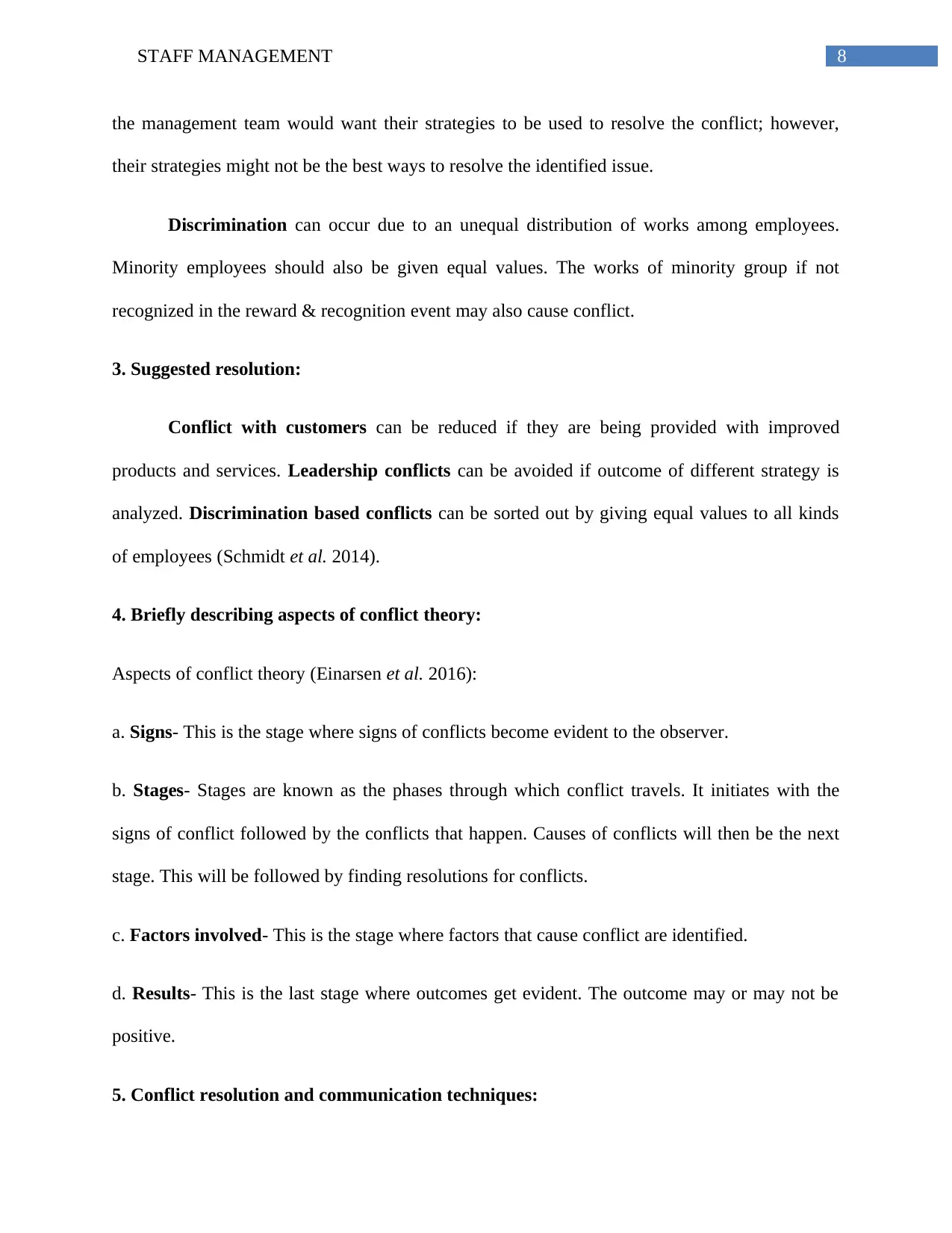
8STAFF MANAGEMENT
the management team would want their strategies to be used to resolve the conflict; however,
their strategies might not be the best ways to resolve the identified issue.
Discrimination can occur due to an unequal distribution of works among employees.
Minority employees should also be given equal values. The works of minority group if not
recognized in the reward & recognition event may also cause conflict.
3. Suggested resolution:
Conflict with customers can be reduced if they are being provided with improved
products and services. Leadership conflicts can be avoided if outcome of different strategy is
analyzed. Discrimination based conflicts can be sorted out by giving equal values to all kinds
of employees (Schmidt et al. 2014).
4. Briefly describing aspects of conflict theory:
Aspects of conflict theory (Einarsen et al. 2016):
a. Signs- This is the stage where signs of conflicts become evident to the observer.
b. Stages- Stages are known as the phases through which conflict travels. It initiates with the
signs of conflict followed by the conflicts that happen. Causes of conflicts will then be the next
stage. This will be followed by finding resolutions for conflicts.
c. Factors involved- This is the stage where factors that cause conflict are identified.
d. Results- This is the last stage where outcomes get evident. The outcome may or may not be
positive.
5. Conflict resolution and communication techniques:
the management team would want their strategies to be used to resolve the conflict; however,
their strategies might not be the best ways to resolve the identified issue.
Discrimination can occur due to an unequal distribution of works among employees.
Minority employees should also be given equal values. The works of minority group if not
recognized in the reward & recognition event may also cause conflict.
3. Suggested resolution:
Conflict with customers can be reduced if they are being provided with improved
products and services. Leadership conflicts can be avoided if outcome of different strategy is
analyzed. Discrimination based conflicts can be sorted out by giving equal values to all kinds
of employees (Schmidt et al. 2014).
4. Briefly describing aspects of conflict theory:
Aspects of conflict theory (Einarsen et al. 2016):
a. Signs- This is the stage where signs of conflicts become evident to the observer.
b. Stages- Stages are known as the phases through which conflict travels. It initiates with the
signs of conflict followed by the conflicts that happen. Causes of conflicts will then be the next
stage. This will be followed by finding resolutions for conflicts.
c. Factors involved- This is the stage where factors that cause conflict are identified.
d. Results- This is the last stage where outcomes get evident. The outcome may or may not be
positive.
5. Conflict resolution and communication techniques:
⊘ This is a preview!⊘
Do you want full access?
Subscribe today to unlock all pages.

Trusted by 1+ million students worldwide
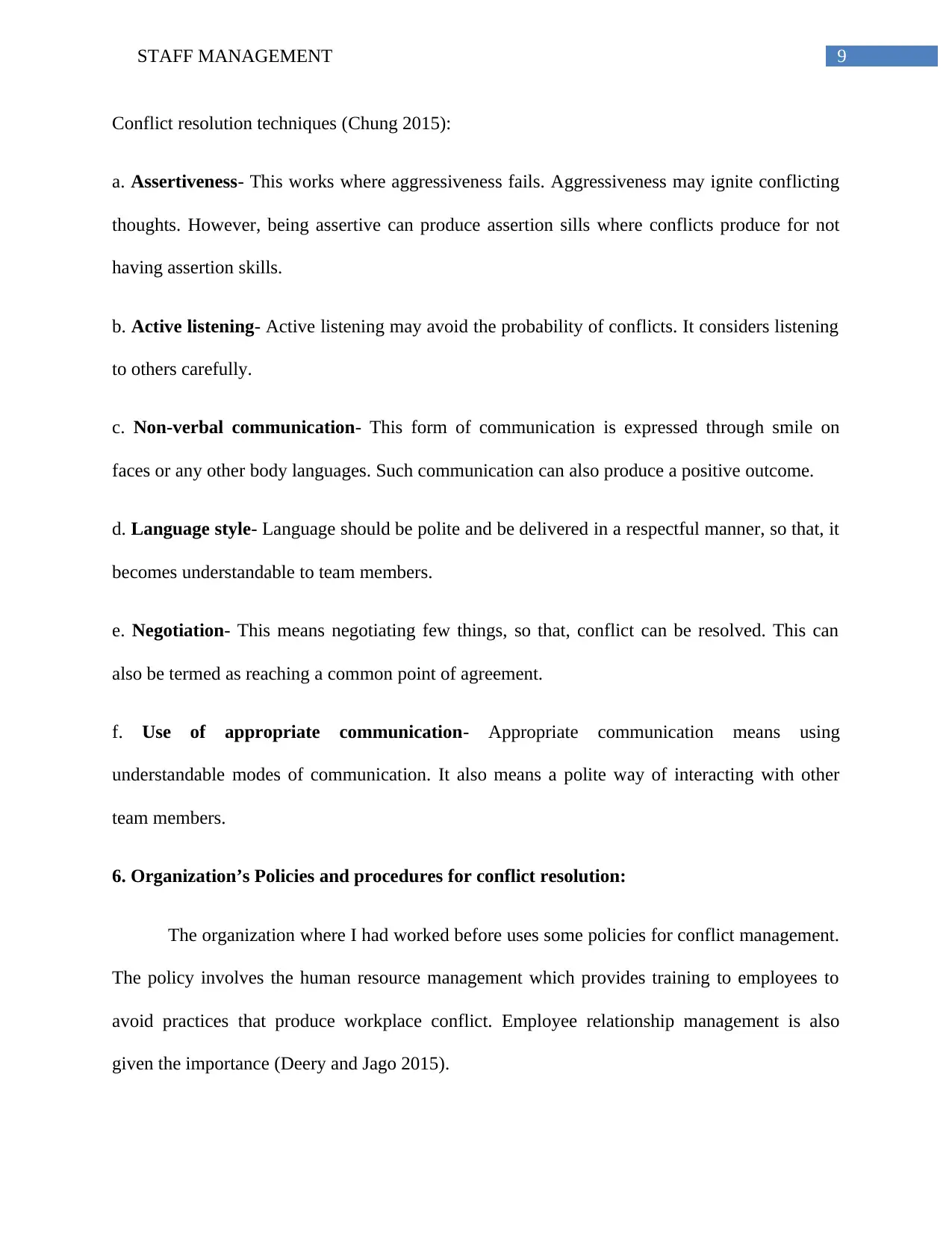
9STAFF MANAGEMENT
Conflict resolution techniques (Chung 2015):
a. Assertiveness- This works where aggressiveness fails. Aggressiveness may ignite conflicting
thoughts. However, being assertive can produce assertion sills where conflicts produce for not
having assertion skills.
b. Active listening- Active listening may avoid the probability of conflicts. It considers listening
to others carefully.
c. Non-verbal communication- This form of communication is expressed through smile on
faces or any other body languages. Such communication can also produce a positive outcome.
d. Language style- Language should be polite and be delivered in a respectful manner, so that, it
becomes understandable to team members.
e. Negotiation- This means negotiating few things, so that, conflict can be resolved. This can
also be termed as reaching a common point of agreement.
f. Use of appropriate communication- Appropriate communication means using
understandable modes of communication. It also means a polite way of interacting with other
team members.
6. Organization’s Policies and procedures for conflict resolution:
The organization where I had worked before uses some policies for conflict management.
The policy involves the human resource management which provides training to employees to
avoid practices that produce workplace conflict. Employee relationship management is also
given the importance (Deery and Jago 2015).
Conflict resolution techniques (Chung 2015):
a. Assertiveness- This works where aggressiveness fails. Aggressiveness may ignite conflicting
thoughts. However, being assertive can produce assertion sills where conflicts produce for not
having assertion skills.
b. Active listening- Active listening may avoid the probability of conflicts. It considers listening
to others carefully.
c. Non-verbal communication- This form of communication is expressed through smile on
faces or any other body languages. Such communication can also produce a positive outcome.
d. Language style- Language should be polite and be delivered in a respectful manner, so that, it
becomes understandable to team members.
e. Negotiation- This means negotiating few things, so that, conflict can be resolved. This can
also be termed as reaching a common point of agreement.
f. Use of appropriate communication- Appropriate communication means using
understandable modes of communication. It also means a polite way of interacting with other
team members.
6. Organization’s Policies and procedures for conflict resolution:
The organization where I had worked before uses some policies for conflict management.
The policy involves the human resource management which provides training to employees to
avoid practices that produce workplace conflict. Employee relationship management is also
given the importance (Deery and Jago 2015).
Paraphrase This Document
Need a fresh take? Get an instant paraphrase of this document with our AI Paraphraser
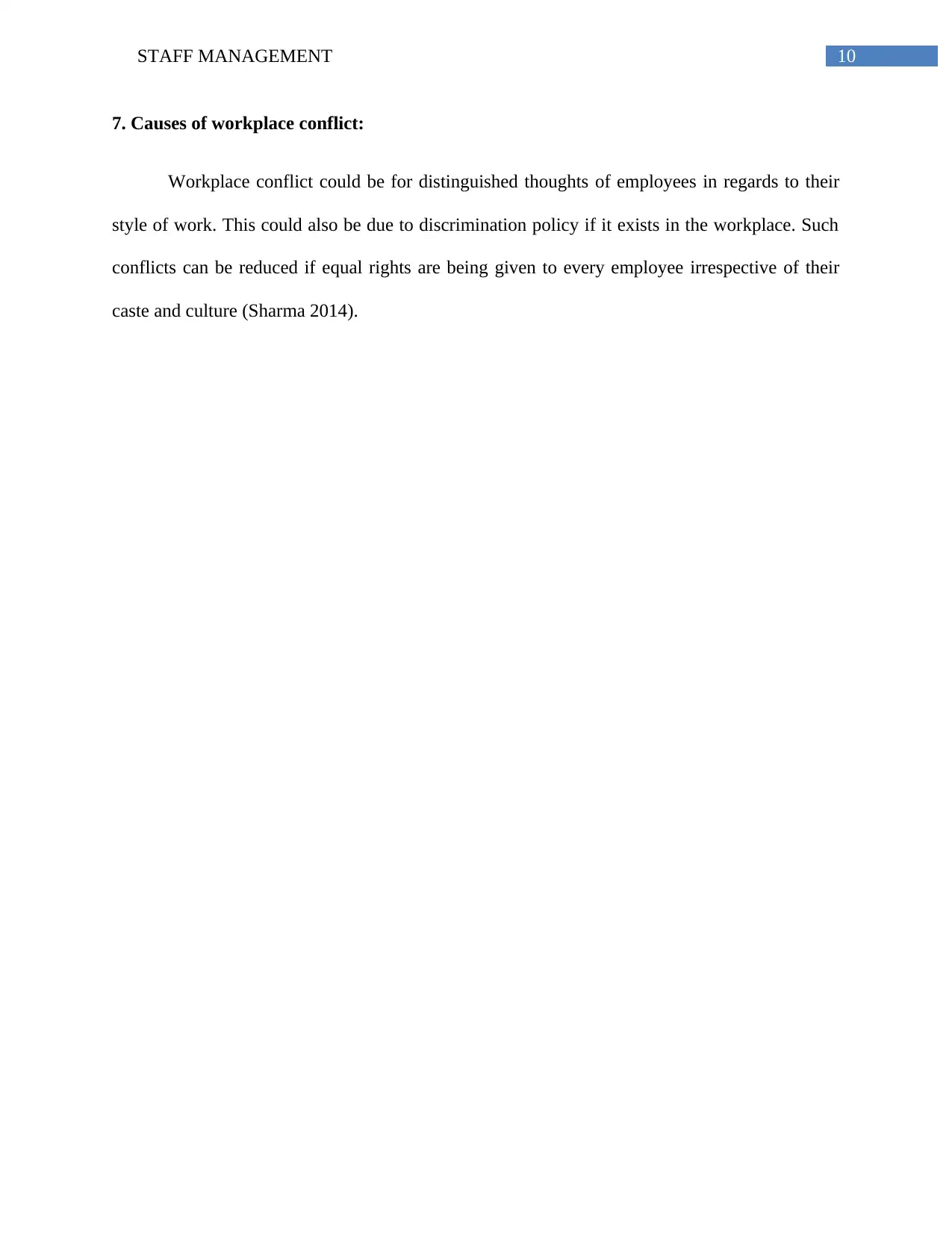
10STAFF MANAGEMENT
7. Causes of workplace conflict:
Workplace conflict could be for distinguished thoughts of employees in regards to their
style of work. This could also be due to discrimination policy if it exists in the workplace. Such
conflicts can be reduced if equal rights are being given to every employee irrespective of their
caste and culture (Sharma 2014).
7. Causes of workplace conflict:
Workplace conflict could be for distinguished thoughts of employees in regards to their
style of work. This could also be due to discrimination policy if it exists in the workplace. Such
conflicts can be reduced if equal rights are being given to every employee irrespective of their
caste and culture (Sharma 2014).
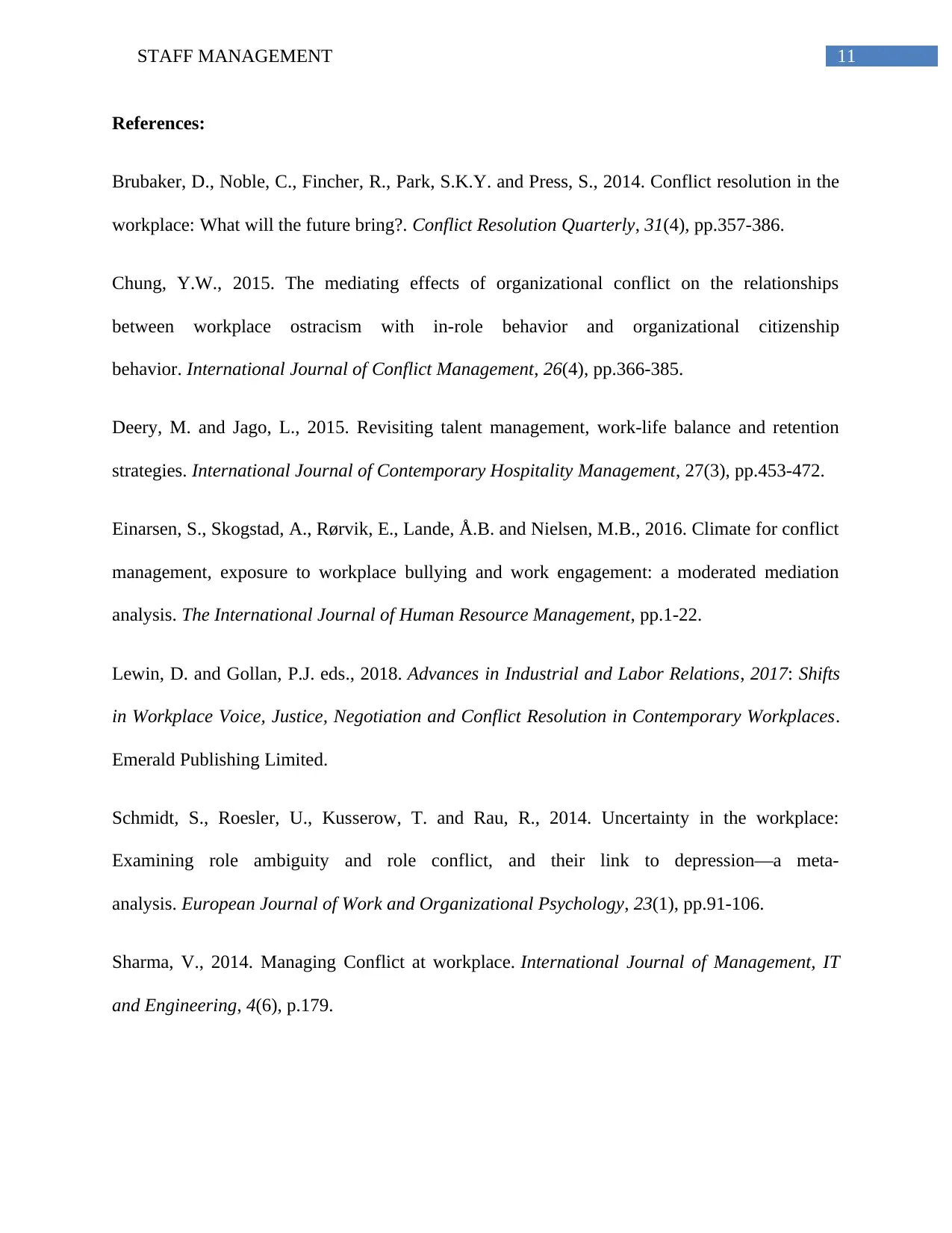
11STAFF MANAGEMENT
References:
Brubaker, D., Noble, C., Fincher, R., Park, S.K.Y. and Press, S., 2014. Conflict resolution in the
workplace: What will the future bring?. Conflict Resolution Quarterly, 31(4), pp.357-386.
Chung, Y.W., 2015. The mediating effects of organizational conflict on the relationships
between workplace ostracism with in-role behavior and organizational citizenship
behavior. International Journal of Conflict Management, 26(4), pp.366-385.
Deery, M. and Jago, L., 2015. Revisiting talent management, work-life balance and retention
strategies. International Journal of Contemporary Hospitality Management, 27(3), pp.453-472.
Einarsen, S., Skogstad, A., Rørvik, E., Lande, Å.B. and Nielsen, M.B., 2016. Climate for conflict
management, exposure to workplace bullying and work engagement: a moderated mediation
analysis. The International Journal of Human Resource Management, pp.1-22.
Lewin, D. and Gollan, P.J. eds., 2018. Advances in Industrial and Labor Relations, 2017: Shifts
in Workplace Voice, Justice, Negotiation and Conflict Resolution in Contemporary Workplaces.
Emerald Publishing Limited.
Schmidt, S., Roesler, U., Kusserow, T. and Rau, R., 2014. Uncertainty in the workplace:
Examining role ambiguity and role conflict, and their link to depression—a meta-
analysis. European Journal of Work and Organizational Psychology, 23(1), pp.91-106.
Sharma, V., 2014. Managing Conflict at workplace. International Journal of Management, IT
and Engineering, 4(6), p.179.
References:
Brubaker, D., Noble, C., Fincher, R., Park, S.K.Y. and Press, S., 2014. Conflict resolution in the
workplace: What will the future bring?. Conflict Resolution Quarterly, 31(4), pp.357-386.
Chung, Y.W., 2015. The mediating effects of organizational conflict on the relationships
between workplace ostracism with in-role behavior and organizational citizenship
behavior. International Journal of Conflict Management, 26(4), pp.366-385.
Deery, M. and Jago, L., 2015. Revisiting talent management, work-life balance and retention
strategies. International Journal of Contemporary Hospitality Management, 27(3), pp.453-472.
Einarsen, S., Skogstad, A., Rørvik, E., Lande, Å.B. and Nielsen, M.B., 2016. Climate for conflict
management, exposure to workplace bullying and work engagement: a moderated mediation
analysis. The International Journal of Human Resource Management, pp.1-22.
Lewin, D. and Gollan, P.J. eds., 2018. Advances in Industrial and Labor Relations, 2017: Shifts
in Workplace Voice, Justice, Negotiation and Conflict Resolution in Contemporary Workplaces.
Emerald Publishing Limited.
Schmidt, S., Roesler, U., Kusserow, T. and Rau, R., 2014. Uncertainty in the workplace:
Examining role ambiguity and role conflict, and their link to depression—a meta-
analysis. European Journal of Work and Organizational Psychology, 23(1), pp.91-106.
Sharma, V., 2014. Managing Conflict at workplace. International Journal of Management, IT
and Engineering, 4(6), p.179.
⊘ This is a preview!⊘
Do you want full access?
Subscribe today to unlock all pages.

Trusted by 1+ million students worldwide
1 out of 13
Your All-in-One AI-Powered Toolkit for Academic Success.
+13062052269
info@desklib.com
Available 24*7 on WhatsApp / Email
![[object Object]](/_next/static/media/star-bottom.7253800d.svg)
Unlock your academic potential
Copyright © 2020–2025 A2Z Services. All Rights Reserved. Developed and managed by ZUCOL.